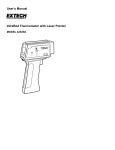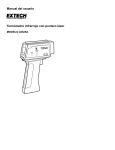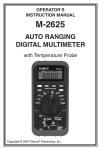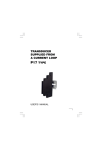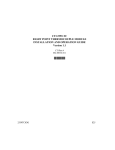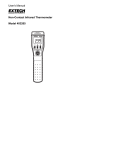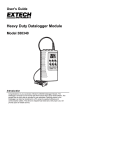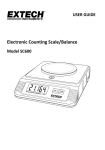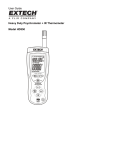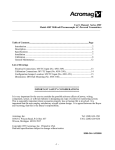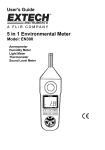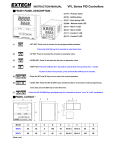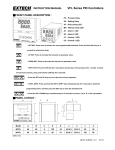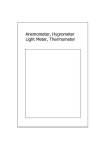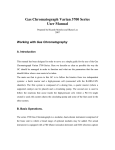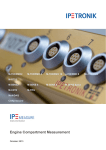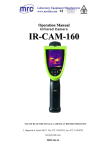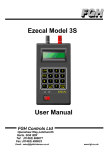Download User`s Manual InfraRed Thermometer with Laser Pointer
Transcript
User’s Manual InfraRed Thermometer with Laser Pointer MODEL 42525A Introduction Congratulations on your purchase of Extech’s 42525A IR Thermometer. The Model 42525A provides non-contact (IR) and contact (type K) temperature measurement capability. The built-in laser pointer (activated by pressing the meter’s trigger) increases target accuracy. The Model 42525A has an RS-232 PC Interface jack for recording readings as they are taken. Professional features include EMISSIVITY ADJUST, RELATIVE MODE, DATA HOLD, DISPLAY OFFSET, and MIN MAX DISPLAY. Proper use and care of this meter will provide years of reliable service. Safety 1. Use extreme caution when the laser beam is ON 2. Do not point the beam toward anyone's eye 3. Be careful not to let the beam strike the eye from a reflective surface 4. Do not use the laser near explosive gases or in other potentially explosive areas Warranty EXTECH INSTRUMENTS CORPORATION warrants this instrument to be free of defects in parts and workmanship for one year from date of shipment (a six month limited warranty applies to sensors and cables). If it should become necessary to return the instrument for service during or beyond the warranty period, contact the Customer Service Department at (781) 890-7440 ext. 210 for authorization or visit our website www.extech.com for contact information. A Return Authorization (RA) number must be issued before any product is returned to Extech. The sender is responsible for shipping charges, freight, insurance and proper packaging to prevent damage in transit. This warranty does not apply to defects resulting from action of the user such as misuse, improper wiring, operation outside of specification, improper maintenance or repair, or unauthorized modification. Extech specifically disclaims any implied warranties or merchantability or fitness for a specific purpose and will not be liable for any direct, indirect, incidental or consequential damages. Extech's total liability is limited to repair or replacement of the product. The warranty set forth above is inclusive and no other warranty, whether written or oral, is expressed or implied. 2 Model 42525A Version 4.0 5/05 Specifications General Specifications Display 0.4" (10mm) 5-digit LCD display Sample rate 1 sec. approx. Over range indication Dashes are displayed when the reading exceeds specified limits Laser pointer Laser power < 1mW (red) Max/Min Recording Allows user to view only the MAX or MIN readings Data output RS-232c PC Interface for use with WindowsTM based communications programs; Connection via 3.5mm phono jack on side of meter Operating Temperature 32°F to 122°F (0°C to 50°C) Operating Humidity 80% RH maximum Power Supply 9V battery Battery Life Approx. 40 hours (20 hours with laser pointer ON) Weight 0.6 lbs. / 265g Dimensions 7.7 x 4.7 x 2.3” (195 x 120 x 58 mm) Infrared Thermometer Specifications Range / Resolution -4 to 752oF (-20 to 400oC) 0.1oC/F Accuracy ± 3% of reading or ± 6oF (3oC) whichever is greater Accuracy notes 1. 2. 3. 4. 5. Emissivity adjust 0.20 to 1.00 (factory default: 0.95) Distance Factor D/S = Approx. 6:1 ratio (D = distance, S = spot) Wavelength 6 to 14 µm Accuracy specified for readings between -10 and 350oC Accuracy specified for ambient temperature (23oC ±5oC) Accuracy specified for an emissivity of 0.95 Accuracy tested using 2.25” diameter black body at a distance of 6” Testing environment: RF field strength < 3 V/M and frequency < 30MHz Type K Thermocouple Specifications Range / Resolution -148.0 to 2372.0oF (-100.0 to 1300.0oC) Accuracy ± (1% reading + 2oF); ± (1% reading + 1oC) Accuracy note Accuracy specified @ 23o ± 5oC Thermocouple characteristics are not reflected in the Accuracy specs. Linearity correction stored in CPU Sensor type Type K (NiCr – NiAl) Thermocouple (sold separately); Connects to thermocouple jack on side of meter 3 0.1oC/F Model 42525A Version 4.0 5/05 Meter Description 1. LCD Display 2. Function buttons • C/F Button (also the UP button): Used to select temperature units. Also used as an UP arrow button for setting the emissivity value • Emissivity button: Enter the emissivity adjustment mode • Relative button (also the DOWN button): Used to access the RELATIVE mode of operation. Also used as the DOWN arrow button for setting the emissivity. • Record button: Used when viewing the MAX and MIN readings • Data Hold button: Used to freeze the displayed reading 3. POWER button: Turns meter ON or OFF 4. IR/Type K button: Selects IR (non-contact) or Type K (contact) operation 5. RS-232 PC Interface jack 6. IR Sensor 7. Laser pointer 8. Type K input jack 9. Laser pointer trigger 10. Handle grip 11. Battery Compartment 4 Model 42525A Version 4.0 5/05 Operating Instructions Infrared Measurement Procedure 1. Turn the meter ON by pressing the POWER button. The meter display will countdown (99999, 88888, 77777…00000) during the self-test procedure. When the self-test is complete, the display will indicate a temperature reading, the unit of measure, the emissivity setting, and the measurement type (IR for non-contact or Type K for contact measurements). 2. Use the IR / TYPE K button to set the display to the IR mode (IR will appear in the lower left-hand side of the LCD). 3. Set the temperature units (oC or oF) using the C/F button. 4. Point the IR sensor toward the object under test (to assist with targeting, press the meter trigger to activate the laser pointer). 5. This meter has a “distance to spot ratio” of 6:1. Use the diagram below to determine the proper distance to hold the meter from an object. For example, if the object under test has a diameter of 4”, hold the meter at a distance of approximately 26”. 6. Read the LCD display for the temperature measurement. Note that the current emissivity setting is shown on the lower right-hand corner of the LCD. Diameter of Spot 150 6 125 5 100 4 75 3 50 2 mm inch 1000 40 840 33 670 26.4 500 20 330 13 mm inch Distance to Object Infrared Measurement Considerations 1. The 42525A automatically compensates for ambient temperature deviations; however it may take up to 30 minutes to adjust to extremely wide ambient temperature changes. 2. When low temperature measurements are taken followed by high temperature measurements, several minutes are required for stabilization before the high temperature measurements can be made accurately. 3. Measurement Field / Distance: For optimum accuracy, the object should be 1.5 to 2 times larger than the spot size shown in the diagram above and on the meter side. 4. Measurement Interference: Objects having low emissivity or objects with low temperature yet high emissivity emit little IR energy. Such objects are adversely affected by IR energy radiated from nearby objects having high emissivity and temperature. For example, when such objects are measured in sunlight, erratic readings occur because of the powerful radiation (sunlight) reflected off of the object's surface into the 42525A sensor. 5. If the surface of the object under test is covered with frost, oil, grime, etc. clean before taking measurements. 6. If an object's surface is highly reflective, apply masking tape or flat black paint (emissivity 0.95) before measuring. 5 Model 42525A Version 4.0 5/05 Emissivity Considerations and Adjustment The amount of IR energy emitted by an object is proportional to an object's temperature and its ability to emit energy. This ability is known as emissivity. Emissivity is determined by the material of the object and the object’s surface finish. Emissivity values range from 0.1 for a very reflective object to 1.00 for a flat black finish. The Model 42525A uses a factory default emissivity setting of 0.95 (this setting covers most applications). The closer the meter's emissivity setting is to the actual emissivity of the object under test, the more accurate the temperature measurements will be. To calculate the emissivity of an object: Measure an object's temperature using a Type K Thermocouple (use of a surfacemount thermocouple works best for this purpose) and note the reading. Measure the object again using the IR sensor. Now, set the emissivity so that the IR measurement matches the thermocouple reading. To set the emissivity: 1. Press and hold the Emissivity button until the emissivity display starts to flash. 2. Use the UP/DOWN arrow buttons to select the desired emissivity 3. Press and hold the Emissivity button until the display stops flashing to exit Emissivity Factors for Common Materials Material under test Asphalt Concrete Cement Sand Soil Water Ice Snow Glass Ceramic Marble Plaster Mortar Brick Emissivity 0.90 to 0.98 0.94 0.96 0.90 0.92 to 0.96 0.92 to 0.96 0.96 to 0.98 0.83 0.90 to 0.95 0.90 to 0.94 0.94 0.80 to 0.90 0.89 to 0.91 0.93 to 0.96 Material under test Cloth (black) Skin (human) Lather Charcoal (powder) Lacquer Lacquer (matt) Rubber (black) Plastic Timber Paper Chromium Oxides Copper Oxides Iron Oxides Textiles Emissivity 0.98 0.98 0.75 to 0.80 0.96 0.80 to 0.95 0.97 0.94 0.85 to 0.95 0.90 0.70 to 0.94 0.81 0.78 0.78 to 0.82 0.90 Data Hold Press the HOLD button to freeze the displayed measurement. The “HOLD” icon will appear on the LCD to indicate that the Data Hold mode is activated. Press the HOLD button again to exit the Data Hold mode and return to normal operation. Relative Measurements While measuring, press the REL button to activate the Relative Mode (REL will appear on the LCD in the upper right-hand corner). The measurement on the LCD at the time of the button press will be displayed as 0.0o. Subsequent readings will be displayed as a difference between the stored reading and the actual reading. Relative does not function when either Data Hold or Data Record is enabled. 6 Model 42525A Version 4.0 5/05 Max/Min Recording The Max/Min Recording feature offers the user to view only the highest (maximum MAX) or the lowest (minimum MIN) reading. Press the REC button once to activate this feature (the REC symbol will appear on the LCD). Press the REC button again to view only the maximum reading (MAX). Press the REC button again to view only the minimum reading (MIN). Press and hold the RECORD button again until the REC/MAX/MIN icons switch off to return to normal operation. Laser Pointer Operation This 42525A is equipped with a laser pointer that is used to aim the IR sensor more accurately. Simply press the meter trigger to activate the laser pointer. Be extremely cautious when directing the laser beam, shining the laser beam into someone's eye can cause serious injury. Point the laser beam toward the device under test whose temperature is to be measured. Offset Adjustment The OFFSET function allows the user to adjust the temperature readings in fine detail to match an external calibrator, to compensate for display drift, or for other diagnostic uses. Press and hold the HOLD and the REC buttons simultaneously. The small digits on the lower right will match the temperature display of the larger digits when the two buttons are held down correctly. While continuing to hold down the two keys, press the UP or DOWN buttons to set the offset value on the larger digits. Release all keys to return to normal operation. Type K Thermocouple Measurement Procedure 1. 2. 3. 4. 5. 6. Connect a Type K Thermocouple to the temperature input jack on the meter. Power the meter by pressing the POWER button. Use the IR / TYPE K button to select Type K mode (display will show ‘K’). Set the temperature units (degrees C or F) using the C/F button. Place the Thermocouple in the area where the temperature is to be measured. Read the LCD display for the temperature measurement. Type K Measurement Considerations When a Type K Thermocouple is first connected to the meter and the thermocouple and meter temperatures are different, several minutes should be allotted so that the temperature of the socket matches the temperature of the thermocouple. The cold junction compensation circuitry can then operate efficiently, allowing the meter to provide measurements with optimum accuracy. Auto Power Off The meter will automatically power off after approximately 10 minutes in both IR and Thermocouple measurement modes. To disable this feature, press the REC button. RS-232 Serial PC Interface This instrument includes a built-in RS-232 serial data port. This interface is intended for use with the optional Data Acquisition Software and Cable . For more information, contact Extech or refer to the manual with software package. 7 Model 42525A Version 4.0 5/05 Maintenance Battery Replacement When the low battery symbol appears on the LCD, replace the meter’s 9V battery. The battery compartment is located on the bottom of the meter's handle. Open the compartment by sliding the battery compartment cover off. Replace battery and re-install the battery compartment cover. Cleaning Wipe meter with a damp cloth when necessary. A mild detergent may be used but avoid solvents, abrasives, and harsh cleansers. Do not allow moisture inside the meter. Storage Remove the battery if the meter is to be stored for long periods. Do not store the meter in an environment that exceeds the published operating temperature and humidity specifications. Calibration and Repair Services Extech offers complete repair and calibration services for most products we sell. For periodic calibration, NIST certification or repair of most Extech products, call customer service for details. Extech recommends that calibration be performed on an annual basis to insure calibration integrity. Support line (781) 890-7440 Technical support: Extension 200; E-mail: [email protected] Repair & Returns: Extension 210; E-mail: [email protected] Product specifications subject to change without notice For the latest version of this User’s Guide, Software updates, and other up-to-the-minute product information, visit our website: www.extech.com Copyright © 2005 Extech Instruments Corporation All rights reserved including the right of reproduction in whole or in part in any form 8 Model 42525A Version 4.0 5/05








